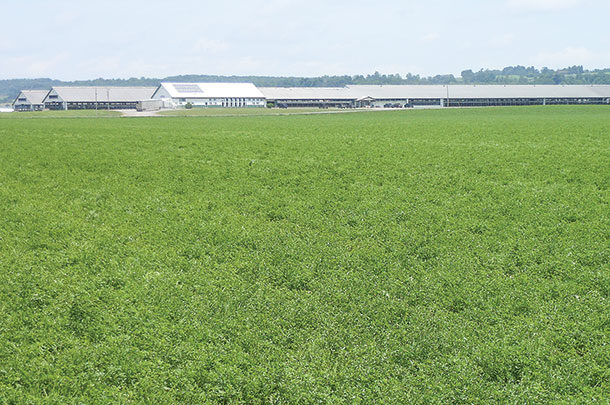While this could be the case for alfalfa in many parts of the U.S. and Canada, it is relatively unlikely in the Northeast, where perennial grasses are often sown with alfalfa. There are pros and cons to alfalfa-grass mixtures, both agronomically and from an animal-feeding standpoint.
Northeast is different from the Midwest
We conducted a survey of alfalfa acreage in New York during the fall of 2014 with most data provided courtesy of agronomic consultants in the state (Figure 1).
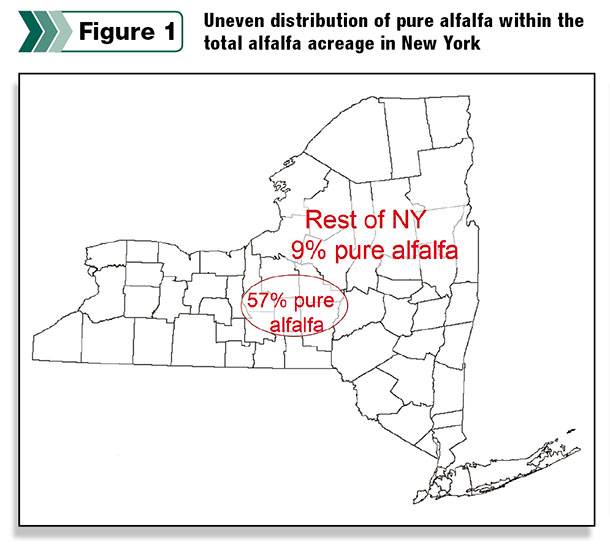
Data from 185,000 alfalfa acres was obtained from 564 farms: 30 percent small (less than 500 acres per farm), 40 percent medium and 30 percent large (greater than 1,500 acres per farm). Overall, only 16 percent of the alfalfa acreage was seeded as pure alfalfa; the rest was seeded with perennial grass.
Most of the alfalfa acreage in this survey (68 percent) was on large farms, and large farms averaged only 15 percent pure alfalfa for their alfalfa acreage. The largest percentage of alfalfa acreage that was pure alfalfa was found on small farms (22 percent), the opposite of what was expected.
Most pure alfalfa acreage is located in central New York. It appears that less than 0.5 percent of New York alfalfa acreage is currently planted with RR alfalfa cultivars.
Grasses are also different
In 1960, more than 90 percent of perennial grass seed sales in New York were timothy seed; it has been steadily declining ever since. Timothy is now considered less desirable, primarily due to low protein content compared to other grasses but also due to its relatively low productivity after spring growth.
An informal survey of forage seed companies active in New York in 2014 found timothy to still be more than 30 percent of all forage grass seed sales, with tall fescue and orchardgrass each around 20 percent of grass seed sales.
Eight other grass species make up the remaining 30 percent, with each of these less than 10 percent of total seed sales. Forage tall fescue seed sales went from essentially zero 10 years ago to 20 percent of grass seed sales, and most of it is seeded with alfalfa.
Seedings of meadow fescue or tall fescue, alone or in combination with alfalfa, were evaluated in 2014. Pure grass stands at four locations averaged 4 percent more tall fescue yield than meadow fescue when cut three times per season and 9 percent more tall fescue yield when cut four times.
However, seeding these grasses in mixtures with alfalfa resulted in similar grass yields for both fescues, as was found in Wisconsin studies.
Do you want more alfalfa in mixed stands?
Rarely do farmers complain that there is too much alfalfa in their alfalfa-grass stands. The relative order of importance of the factors affecting the alfalfa-to-grass ratio in the Northeast are shown in Table 1. They may be somewhat different in other regions.
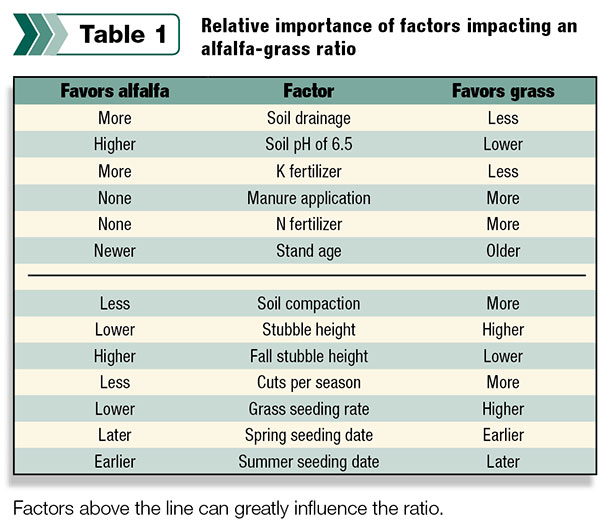
More alfalfa in mixtures begins with site selection that includes reasonable drainage, moderate pH, little soil compaction and plenty of soil potassium (not an easy task to identify in many areas of the Northeast). Any form of N fertilization will strongly encourage grass over alfalfa. Shorter crop rotations will result in fields with more alfalfa in the mixture.
A number of other factors have a significant, but usually less dramatic, influence on alfalfa percentage in mixed stands. Mowing at a lower stubble height will favor alfalfa, except in the fall where a higher stubble height will favor alfalfa. Less cuts per season will put less stress on alfalfa, compared to grass.
Increasing the seeding rate of grass may increase grass percentage in the stand (Figure 2), but alfalfa seeding rate has less influence on stand composition. The particular seeding environment will have a larger impact on establishment of alfalfa versus grass compared to grass seeding rate.
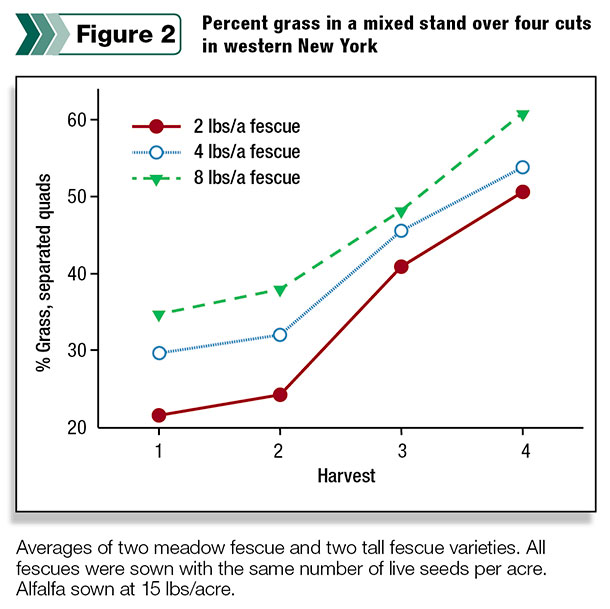
We have used 3 pounds of grass seed in mixtures and ended up with almost all grass in one year, but seeding again the next year at the same site ended up being almost all alfalfa. Finally, seeding later in the spring or earlier in late summer will favor alfalfa over grass.
Pros and cons
Over the life of a stand, alfalfa-grass mixtures can out-yield pure alfalfa stands (Table 2). Stand life is longer because grass may fill in as alfalfa plants die. A grass component reduces winterkill with an insulating effect on alfalfa, especially reducing alfalfa heaving. Grasses make the stand less vulnerable to wheel traffic damage.
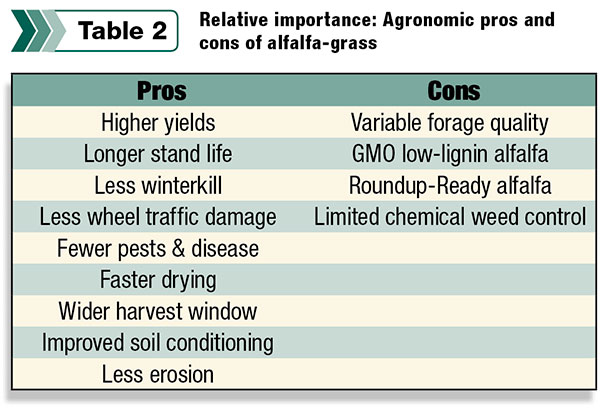
Mixed stands have less leafhopper damage. In general, mixed-species stands are less susceptible to pests and disease. Mixtures dry faster in the field than pure alfalfa.
The harvest window on regrowth harvests of mixed stands may be wider because grass regrowth is mostly leaves with slower decline in forage quality over time. The massive fibrous root system of grasses protects and conditions the soil, improving overall soil health.
The primary negative point with mixtures is not lower forage quality but variable forage quality. The main cause of this variability is a variable alfalfa-to-grass ratio.
All of the factors in Table 1 significantly impact alfalfa-grass ratios, and this results in a changing ratio during the season and over several seasons.
Low-lignin alfalfa is potentially a great trait for alfalfa-grass mixtures. The problem is that some of these new varieties are GMO types, and it appears that these will be stacked with the RR trait. This could make most low-lignin alfalfa varieties unavailable or less desirable for use in mixtures.
Related to the RR issue, alfalfa-grass mixtures have limited or no chemical weed control options. There is a less practical option of seeding RR alfalfa and then drilling grass into the alfalfa seeding after weeds are controlled with the Roundup application.
Best bet
Right now, our best bet is to first select a site reasonably well-drained with near-neutral pH and maintain high soil K. Then select the latest possible maturity meadow fescue or tall fescue variety and seed grass at 3 to 4 pounds per acre with 12 to 15 pounds alfalfa per acre.
Manage it with four cuts per season with a 4-inch stubble height (somewhat higher in fall). If orchardgrass is preferred, try a very late-maturing Canadian orchardgrass variety (“Dividend VL”) or a sparse-heading orchardgrass when it is available commercially. Orchardgrass is extremely competitive with alfalfa in the Northeast.
Alfalfa-grass can be a challenge to maintain a mixture of around 30 to 40 percent grass, and consequently to maintain relatively consistent forage quality, but the pros outweigh the cons. FG
Acknowledgment: Alfalfa-grass research was made possible by funding from the New York Farm Viability Institute and the Northern New York Agricultural Development Program.
Debbie Cherney is an associate professor of Animal Science at Cornell University.
PHOTO: Curtin Dairy, Cassville, NY, with 1800 acres of alfalfa-grass. Photo courtesy of Jerry Cherney.

-
Jerry Cherney
- E.V. Baker
- Professor of Agriculture
- Cornell University
- Email Jerry Cherney
